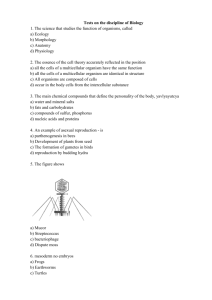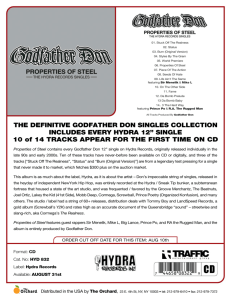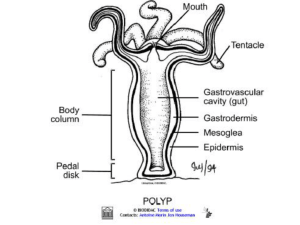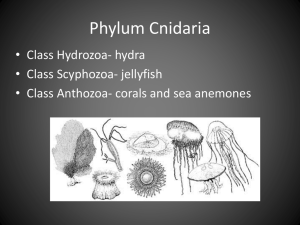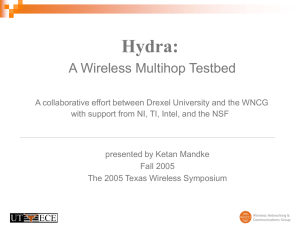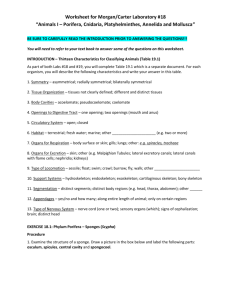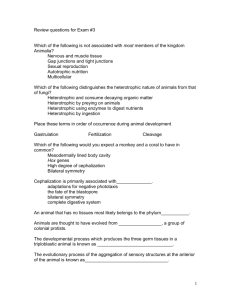estudo do ciclo de vida de hydra viridissima pallas, 1766 (cnidaria
advertisement
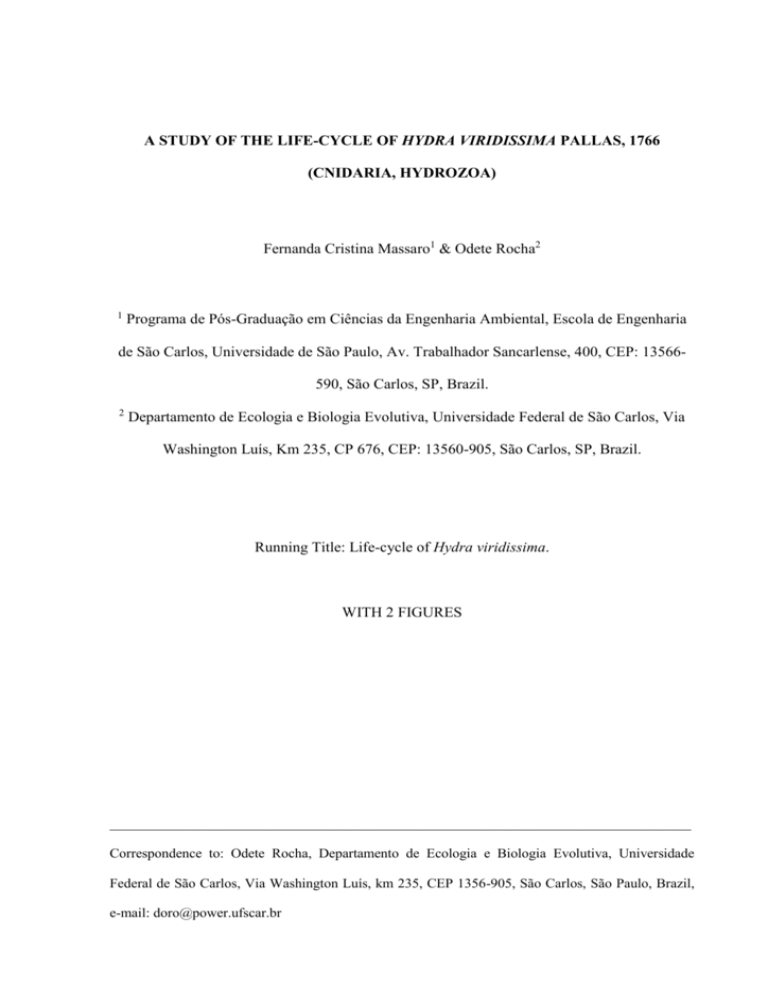
A STUDY OF THE LIFE-CYCLE OF HYDRA VIRIDISSIMA PALLAS, 1766 (CNIDARIA, HYDROZOA) Fernanda Cristina Massaro1 & Odete Rocha2 1 Programa de Pós-Graduação em Ciências da Engenharia Ambiental, Escola de Engenharia de São Carlos, Universidade de São Paulo, Av. Trabalhador Sancarlense, 400, CEP: 13566590, São Carlos, SP, Brazil. 2 Departamento de Ecologia e Biologia Evolutiva, Universidade Federal de São Carlos, Via Washington Luís, Km 235, CP 676, CEP: 13560-905, São Carlos, SP, Brazil. Running Title: Life-cycle of Hydra viridissima. WITH 2 FIGURES __________________________________________________________________________________ Correspondence to: Odete Rocha, Departamento de Ecologia e Biologia Evolutiva, Universidade Federal de São Carlos, Via Washington Luís, km 235, CEP 1356-905, São Carlos, São Paulo, Brazil, e-mail: doro@power.ufscar.br Abstract: A study of the life-cycle of Hydra Viridissima Pallas, 1766 (Cnidaria, Hydrozoa). Owing to the scarcity of information on the freshwater Cnidaria of São Paulo State and Brazil, this study was planned with the aim of maintaining a population of Hydra viridissima in laboratory culture to enable the determination of the individual and population growth-rates of this species, as well as its population doubling time and generation time, with a view to employing these common animals as test-organisms in ecotoxicological assays. The organisms were maintained in reconstituted water at 20 ± 2ºC, illuminated at 800 lux with a photoperiod of 12 h light: 12 h dark, and were fed on neonates of the cladoceran Ceriodaphnia silvestrii (3 or 4 neonates per hydra, 3 times a week). The individual growthrate (k) of the species was 0.43, the maximum length of the column 2.53 mm and the generation time 6.6 ± 1.5 days on average. The hydra population showed an intrinsic growthrate (r) of 0.0468, according to the fitted curve, and a doubling time of 14.8 ± 2.63 days. Hydra viridissima is easy to growth in the laboratory and performs well in the conditions used in this study. It is thus a promising candidate test-organism for ecotoxicological studies. Key-words: Cnidaria, life-cycle, culture, Hydra viridissima. Resumo: Estudo do ciclo de vida de Hydra viridissima Pallas, 1766 (Cnidaria, Hydrozoa). Considerando-se a escassez de informações sobre os Cnidaria de água doce do Estado de São Paulo e do Brasil, o objetivo do presente estudo foi manter o cultivo em laboratório da espécie Hydra viridissima, determinando-se o crescimento individual e populacional desta espécie, assim como o tempo de duplicação da população e o tempo de geração da mesma, visando sua utilização como organismo-teste em ensaios ecotoxicológicos. Os organismos foram mantidos em água reconstituída, a uma temperatura de 20 2°C, com luminosidade de 800 lux e fotoperíodo de 12 horas luz/ 12 horas escuro, e foram alimentados com neonatas do Cladocera Ceriodaphnia silvestrii (3 a 4 neonatas por indivíduo). A taxa de crescimento individual (k) obtida para esta espécie foi de 0,43, o comprimento máximo da coluna das hidras foi 2,53 mm, e o tempo de geração foi em média de 6,6 1,5 dias. Esta espécie apresentou uma taxa intrínseca de crescimento populacional (r) igual a 0,0468 para a curva ajustada e um tempo de duplicação da população de 14,8 ± 2,63 dias. A espécie Hydra viridissima é de fácil cultivo em laboratório e apresentou um bom desempenho nas condições testadas, sendo, portanto, um potencial organismo-teste para estudos ecotoxicológicos. Palavras-chave: Cnidaria, Ciclo de vida, Cultivo, Hydra viridissima. Introduction The freshwater Cnidaria of São Paulo State, indeed of Brazil as a whole, are relatively little known in comparison with the members of this phylum in the USA or Europe, in spite of being common organisms in most freshwater habitats (Silveira & Schlenz, 1999). In particular, hydras are common in bodies of water in every continent except Antarctica (Holstein, 1995). They are strictly carnivorous, feeding mainly on small crustaceans, including cladocerans and copepods, insects and annelids. Asexual budding is the commonest means of reproduction (Pennak, 1953). Only four species of Hydra (Class Hydrozoa, Subclass Anthomedusae, Family Hydridae) are known in Brazil: Hydra viridissima Pallas, 1766 (Cordero, 1939; Wolle, 1978), Hydra iheringi Cordero, 1939 (Cordero, 1939), Hydra intermedia Wolle, 1978 (Wolle, 1978) and Hydra salmacidis Silveira, Gomes & Silva, 1997 (Silveira et al., 1997). Hydra viridissima (formely Chlorohydra viridissima) appears green, owing to its symbiotic relationship with the green alga, Chlorella vulgaris, which are present in the body of the hydra. The algae are found in vacuoles within the gastrodermal cells, where they are protected from host digestive enzymes (Muscatine, 1974). Up to 20 algal cells may coexist in the same animal cell (Douglas, 1995). The photosynthetic alga supplies nutrients such as maltose (Muscatine, 1965) or glucose-6-phosphate (Lenhoff & Muscatine, 1963; Roffman & Lenhoff, 1969; Kelty & Cook, 1976) to the hydra. When hydras are exposed to toxic substances, they may undergo graded changes in their body structure, observation of which allows the toxicity to be assayed at lethal or sublethal concentrations. Moreover, these organisms are present in a variety of freshwater environments, are easy to culture and maintain in the laboratory, reproduce rapidly and can be used in toxicity tests that are both simple to perform and low-cost (Trottier et al., 1997). In short, Hydra viridissima makes a very promising candidate test-organism for ecotoxicological research. With this end in mind, the objective of this study was to augment existing information on the life-cycle of Hydra viridissima by measuring its population and individual growth-rates under controlled culture conditions, since these characteristics are fundamental to the development of standardized ecotoxicological tests. Materials and Methods Examples of the species Hydra viridissima were collected from outdoor concrete tanks in the Experimental Reserve of the Department of Ecology and Evolutionary Biology at the Federal University of São Carlos (SP, Brazil). The hydras were cultured in circular glass aquaria, 20 cm in diameter, in reconstituted water (ABNT, 2004). The cultures were kept at 20 ± 2ºC, under a light source of 800 lux, with a photoperiod 12 h light: 12 h dark. Three times a week, 3 or 4 neonates of the cladoceran Ceriodaphnia silvestrii per hydra were supplied as food. The water was changed and the culture cleaned twice a week. In both the population and individual growth experiments, the hydras were maintained under the same culture conditions, with 10 replicates each test, but in the individual growth experiment only the individuals of seven replicates had survived until the end of the experiment. In the individual growth experiment, each replicate had one hydra with a single bud. The animal was examined daily under a stereomicroscope provided with a micrometer graticule in the eyepiece and, from the moment the bud separated from the mother polyp, the length and diameter of this knew hydra were measured once a day until it had grown and begun to reproduce, by giving rise to a bud. From then on, the length and diameter of the new bud were measured daily until it, in turn, separated from the mother polyp. The generation time of the species was taken as the time interval between the separation of the original bud from the first polyp and the growth and separation of the new bud. The growth-curve for the body length of Hydra viridissima was obtained by applying Von Bertalanffy’s model (Bertalanffy, 1938), the parameters of which were calculated by using the Ford-Walford transformation (Walford, 1946): Lt = L∞[1 – e –k(t – to)] where: Lt = length in one determined time t (mm); L∞ = maximum length which, on average, the organisms can reach, being the asymptotic limit of the curve; e = base of natural logarithm; k = growth-rate constant; to = parameter related to the initial length of individuals at birth (Lo), expressed in days. Each replicate population growth test started with a population of three full-grown hydras. The individuals were inspected every 2-3 days and counted under a stereomicroscope. These experiments continued for 65 days. The instantaneous natural growth-rate was calculated with the following differential equation (Odum, 1988): dN/dt = rN This may be integrated to give: Nt = N0 e r t where: Nt = number of organisms at time t; N0 = initial number of organisms; t = the duration of the experiment; r = intrinsic population growth-rate; e = base of natural logarithm. The parameter r can be considered an instantaneous coefficient of population growth (Odum, 1988), and is calculated by means of the following expression: r = (ln Nt – ln N0)/t From this coefficient, the population doubling-time (t2) can be obtained: t 2= ln2/r Results The individual length data for Hydra viridissima are plotted in Figure 1, where all the points shown for one day represent replicates. The curve has been fitted to the data, assuming the Von Bertalanffy model for individual growth. Length data were collected from the time a new hydra separated from the mother polyp until the appearance and separation of its first bud. The fitted curve follows the equation: Lt = 2.53 [1 – e -0.43 (t + 1.47)] Thus, the average maximum length reached by hydras was 2.53 mm (L∞) and the daily growth-rate was 0.43 (k), that is the columns lengthened by about 40% every day. It was found that soon after having separated from the mother polyp, the new hydras were 1.2 0.37 mm long and 0.09 0.018 mm in diameter, at 5 1.77 days after separation, on average, they attained a mean length of 2.22 0.37 mm and a diameter of 0.10 0.03 mm, and began to form buds. The buds were also measured, daily, from their first appearance until they separated from the mother hydra. Starting with a mean length 0.28 0.11 mm and diameter 0.12 0.02 mm, they grew, in 1.6 0.5 days on average, to a mean length 0.52 0.2 mm and diameter 0.14 0.07 mm and then separated from the mother polyp. Thus, the mean generation time of Hydra viridissima in the laboratory conditions described was 6.6 1.5 days. An exponential curve has been fitted to the population growth data obtained for Hydra viridissima in Figure 2. The average rate of population growth of this species can be obtained from this curve, which is described by the following equation, with a coefficient of determination (R2) of 0.9511: Nt = 5.785e0.0468t Hence, the instantaneous rate constant for population growth (r) is of 0.0468 by the end of the 65-day experiment, each replicate (initially 3 hydras) had grown, on average, to 109.1 ± 26.4 hydras. The average doubling time for the population of Hydra viridissima, culture in the laboratory, was calculated from r as 14.8 ± 2.63 days. Discussion Regarding the individual growth of Hydra viridissima under the conditions described here, a high rate of elongation was observed (k = 0.43) throughout the period of growth of the new hydra, from its initial separation from the mother polyp until it attained a maximum length (L∞ = 2.53 mm on average) and started to reproduce by budding. The generation time of this species, defined as the time elapsed between the separation of a bud from its mother hydra, to the production and the separation of its first bud, was found to be 6.6 1.5 days. Sugiyama & Fujisawa (1979) culture samples of Hydra magnipapillata, taken from 10 different sites in Japan, at 18 ± 1ºC, and feeding them with Artemia salina. They reported a mean generation time for that species of 8.3 ± 3.22 days, rather longer than that exhibited by Hydra viridissima in the present study. According to Slobodkin et al. (1991), the length of the column of individual hydras varies appreciably within a species, depending on the culture conditions, such as food and temperature, and also on genetic factors. Bossert & Dunn (1986) noted that hydras of the same species, collected at various sites but maintained in laboratory cultures under the same conditions of temperature, light and food, varied in body size. They collected Hydra viridissima polyps from 3 different sites and cultured them in the laboratory at 20ºC, feeding them on Artemia salina. Organisms originating from each site exhibited a different length: 3.75 ± 0.25 mm, 3.06 ± 0.13 mm and 2.29 ± 0.11 mm. Several microcrustaceans and the fish Poecilia reticulata have been employed as testorganisms in ecotoxicological monitoring of water. Fonseca (1991) cultured Ceriodaphnia silvestrii, Daphnia laevis, e Poecilia reticulata and measured their individual growth-rates, obtaining the values k = 0.2950 for Ceriodaphnia silvestrii, 0.122 for Daphnia laevis and 0.088 for females and 0.187 for males of the species Poecilia reticulata. Bohrer (1995) found that the value of k for Moina micrura varied from 0.10 to 0.39. she performed tests to elucidate the influence of food density (Monoraphidium dybowskii), water hardness and pH on the individual growth of this species. In a study of the chronic toxicity of samples of water and sediment, from several sites in the hydrographic basin of the Brazilian River Piracicaba, on cladoceran species, Fonseca (1997) founded values of the individual growth-rates varying from 0.04 to 0.26 for Daphnia similis and from 0.16 to 0.37 for Ceriodaphnia silvestrii, in tests with sediment samples. When water samples were used in the chronic toxicity tests, Fonseca (1997) found values of k that varied from 0.05 to 0.18 for Daphnia similis, from 0.12 to 0.28 for Ceriodaphnia silvestrii and from 0.15 to 0.42 for Ceriodaphnia dubia. Considering the above examples, it can be seen that the individual growth-rate observed for Hydra viridissima in the currently study (0.43) was notably higher. Furthermore, the species exhibited a short generation time, a very useful feature in an ecotoxicological testorganism. Turning to the intrinsic population growth-rate, this species exhibited a value r = 0.0468, with coefficient of determination R2 = 0.9511. In the wild, positive and negative variations of the rate of increase of a population (r) are observed, caused both by intrinsic factors (age structure and genetic make-up of the population) and changing environmental conditions. In controlled conditions in the laboratory, where limiting factors that may affect the population have been eliminated, it is possible to determine the natural capacity for population growth with given combinations of experimental factors, such as temperature, quality and quantity of food, etc. (Krebs, 1986). Sugiyama & Fujisawa (1979) reported a variation in the intrinsic population growthrate of Hydra magnipapillata among specimens collected at different sites, obtaining values of r from 0.06 a 0.26. Sipaúba-Tavares (1988) evaluated a number of zooplankton species as potential food for stocks of fish fry and recorded their population growth-rates in the laboratory, obtaining the following values of r: Daphnia similes 0.15, Daphnia laevis 0.36, Ceriodaphnia silvestrii 0.23, Moina micrura 0.25, Argyrodiaptomus furcatus 0.05 and, highest of all, the rotifer Brachionus falcatus, with 0.54. Fonseca (1991) made a study of the biology and responses in toxicity tests of the cladoceran species Ceriodaphnia silvestrii and Daphnia laevis, which were cultured in the laboratory at a controlled temperature of 25 ± 2ºC and fed on the alga Monoraphidium dybowskii at 105 cells/mL. She found that under these conditions Ceriodaphnia silvestrii had the higher intrinsic population growth-rate (r = 0.32), while r = 0.26 for Daphnia laevis. For the fish Poecilia reticulata, included in the same research and fed on zooplankton under standardized conditions, a value r = 0.009 was found. The microcrustacean Ceriodaphnia silvestrii was also tested by Rocha & Sipaúba – Tavares (1994) and Santos et al. (2004). In the former study, r = 0.28 was found in a population cultured at 24 ± 3ºC, while in the latter, r = 0.53 was reported, for organisms grown at 25 ± 1ºC. Sipaúba –Tavares & Bachion (2002) investigated the effects of diet on the population growth-rate of the zooplankton Moina micrura and Diaphanosoma birgei, which were fed on the following four diets: alga alone, alga plus vitamins, alga plus fish-food and alga, fish-food and vitamins. The values of r varied from 0.43 to 0.69 for Moina micrura and from 0.37 to 0.57 for Diaphanosoma birgei, the highest natural intrinsic rates being obtained with the algavitamin diet, for both species. It will have been noted that the same species may exhibit quite different intrinsic population growth-rates, since the culture and stock maintenance conditions generally vary, as do the temperature and diet during experiments. As the process of growth is specific to each type of organism, it is important to establish the pattern of growth of a species, in order to try and explain the relation between its growth-rates and its habitat (Nikolski, 1963). The natural intrinsic rate of increase observed for Hydra viridissima was 0.0468 a value of r similar to the lowest found by Sugiyama & Fujisawa (1979) for Hydra magnipapillata (0.06) and also to that observed for the calanoid copepod Argyrodiaptomus furcatus (0.05) by Sipaúba-Tavares (1988). On the other hand, this rate of increase was higher than that reported by Fonseca (1991) for the fish Poecilia reticulata (0.009), and lower than the values found for the cladocerans Ceriodaphnia silvestrii, Daphnia laevis, Daphnia similis, Moina micrura and Diaphanosoma birgei, and for the rotifer Brachionus falcatus. Differences between population growth-rates of species can be explained partly by their genomes that result in different life-cycle traits and also because the species were not grown under identical conditions. Knowing the value of r, it is possible to determine the doubling time for a population, by dividing the natural log of 2 (ln 2) by the value of r (Odum, 1988). The Hydra viridissima population grown in the laboratory in this study had a mean doubling time of 14.8 ± 2.63 days. For another species, Hydra magnipapillata, Sugiyama & Fujisawa (1979) found doubling times varying from 3 to 10 days, using standard hydra culturing procedures. Habetha et al. (2003) analyzed the population growth of Hydra viridissima given three different food treatments (fed daily; once a week and once a fortnight on Artemia salina). They observed that the population fed daily doubled in 3 days; those fed once a week, in 14 days, and those fed once a fortnight, in 31 days. Therefore, the doubling time of the Hydra viridissima population studied here was similar to that found by those authors for hydras fed once a week on Artemia salina. According to Bosh & David (1984), the growth rate of Hydra is closely related to the feeding conditions of the organisms. Possibly, the doubling time found in the present study would be shorter if the animals were fed daily. Therefore, it would be interesting, to test different food items to find the food preferences of this species, as well as to test the maximum ingestion rates, in order to establish the best culturing conditions, and hence the highest population growth rate. It was concluded that once an adequate culture medium and food are found it is relatively easy to culture Hydra viridissima in the laboratory. For the conditions established, the species performed well, reproducing quickly and consequently having a short generation time. However, further studies may improve the culture conditions, allowing the standardization of culture procedures, since this species is a potential test-organism for bioassays. Acknowledgements The authors thank CAPES/CNPq for the scholarship awarded to the first author, and to the BIOTA/FAPESP and PRONEX/PROBIO (CNPq/MMA) programs for research funding. References ASSOCIAÇÃO BRASILEIRA DE NORMAS TÉCNICAS – ABNT. NBR 12713, 2004, Ecotoxicologia aquática – Toxicidade aguda – Método de ensaio com Daphnia spp (Cladocera, Crustacea). BERTALANFFY, L. Von, 1938, A quantitative theory of organic growth. Hum. Biol., 10(2):181-213. BOHRER, M. B. C., 1995, Biomonitoramento das lagoas de tratamento terciário do Sistema de Tratamentos dos Efluentes Líquidos Industriais (SITEL) do Pólo Petroquímico do Sul, Triunfo, RS, através da comunidade zooplanctônica. Tese de Doutorado, Universidade Federal de São Carlos, São Carlos, 469p. BOSCH, T. C. & DAVID, C. N., 1984, Growth regulation in Hydra: Relationship between epithelial cell cycle length and growth rate. Dev. Biol., 104:161-171. BOSSERT, P. & DUNN, K. W., 1986, Regulation of intracellular algae by various strains of the symbiotic Hydra viridissima. J. Cell. Sci., 85:187-195. CORDERO, E. H., 1939, Observaciones sobre algunas especies Sud-Americanas del género Hydra. I. Hydra en el Nordeste del Brazil. Anais Acad. Bras. Ci., Rio de Janeiro, 11(4):335-340. DOUGLAS, A. E., 1995, Symbiotic Interactions. Oxford University Press, Inc. FONSECA, A. L., 1991, A biologia das espécies Daphnia laevis, Ceriodaphnia similis, (Crustacea-Cladocera) e Poecilia reticulata (Pisces, Poeciliidae) e o comportamento destes em testes de toxicidade aquática com efluentes industriais. Dissertação de Mestrado, EESC/USP, São Carlos, 210p. FONSECA, A. L., 1997, Avaliação da qualidade da água na bacia do Rio Piracicaba através de testes de toxicidade com invertebrados. Tese de Doutorado, EESC/USP, São Carlos, 217p. HABETHA, M., ANTON-ERXLEBEN, F., NEUMANN, K. & BOSH, T. C. G., 2003, The Hydra viridis/Chlorella simbiosis. Growth and sexual differentiation in polyps without symbionts. Zoology, 106:101-108. HOLSTEIN, T., 1995, Cnidaria: Hydrozoa. In: A. Brauer, J. Schwoerbel & P. Zwick (coords.), Süsswasserfauna von Mitteleuropa. Gustav Fisher Verlag, Stuttgart, p.1-110. KELTY, M. O. & COOK, C. B., 1976, Survival during starvation of symbiotic, aposymbiotic, and non-symbiotic Hydra, pp. 409–414. In: G. O. Mackie (ed.), Coelenterate Ecology and Behavior. Plenum Press, New York. KREBS, C. J., 1986, Ecologia. Análisis experimental de la distribuición y abundancia. 3.ed. Madrid:Ediciones Pirámide, 172p. LENHOFF, H. M. & MUSCATINE, L., 1963, On the role of algae symbiotic with Hydra. Science, 142:956–958. MUSCATINE, L., 1965, Symbiosis of Hydra and algae. III Extracellular products of the algae. Comp. Biochem. Physiol., 16:77–92. MUSCATINE, L., 1974, Endosymbiosis of cnidarians and algae, pp. 359–395. In: H. M. Lenhoff & L. Muscatine (eds.), Coelenterate Biology: Reviews and New Perspectives. Academic Press, New York. NIKOLSKI, G. V., 1963, The ecology of fishes. Academic Press. London and New York, 351p. ODUM, E. P., 1988, Ecologia. Ed. Guanabara Koogan S. A. Rio de Janeiro, 434p. PENNAK, R. W., 1953, Freshwater Invertebrates of the United States. The Ronald Press Company, N. Y., cap. 4, pp. 98-113. ROCHA, O. & SIPAÚBA-TAVARES, L. H., 1994, Cultivo em larga escala de organismos planctônicos para alimentação de larvas e alevinos de peixes: II – organismos zooplanctônicos. Biotemas, 7:94-109. ROFFMAN, B. & LENHOFF, H. M., 1969, Formation of polysaccharides by Hydra from substrates produced by their endosymbiotic algae. Nature, 221:381–382. SANTOS, M. A., MELÃO, M. G. M. & LOMBARDI, M. T., 2004, Respostas do ciclo de vida de Ceriodaphnia silvestrii Daday (Crustacea, Cladocera) à variação nos recursos alimentares, meio de cultivo e presença de substâncias húmicas. Dissertação de Mestrado, Universidade Federal de São Carlos, São Carlos, 127p. SILVEIRA, F. L. & SCHLENZ, E., 1999, Cnidários, pp. 13-15. In: D. Ismael,W. C. Valente, T. M. Tundisi & O. Rocha (eds.), Invertebrados de Água Doce. ed. S. Paulo/SP: FAPESP, v.4, 176p. SILVEIRA, F. L., GOMES, C. S. & SILVA, Z. DE S., 1997, New species of Hydra Linnaeus, 1758 (Cnidaria, Hydrozoa) from southeastern Brazil. Boletim do Museu Nacional, Zoologia, 373:1-15. SIPAÚBA-TAVARES, L. H., 1988, Utilização do plâncton na alimentação de larvas e alevinos de peixes. Tese de Doutorado, Universidade Federal de São Carlos, São Carlos, 191p. SIPAÚBA-TAVARES, L. H. & BACHION, M. A., 2002, Population growth and development of two species of Cladocera, Moina micrura and Diaphanosoma birgei, in laboratory. Braz. J. Biol., 62:701-711. SLOBODKIN, L. B., BOSSERT, P., MATESSI, C. & GATTO, M., 1991, A review of some physiological and evolutionary aspects of body size and bud size of Hydra. Hydrobiologia., 216/217:377-382. SUGIYAMA, T. & FUJISAWA, T., 1979, Genetic analysis of developmental mechanisms in Hydra VII. Statistical analyses of developmental-morphological characters and cellular compositions. Develop., Growth and Differ., 21(4):361-375. TROTTIER, S., BLAISE, C., KUSUI, T. & JOHNSON, E. M., 1997, Acute toxicity assessment of aqueous samples using a microplate–based Hydra attenuata assay. Environm. Toxicol. Water. Qual., 12:265-271. WALFORD, L. A., 1946, A new graphic method of describing the growth animals. Biol. Bull., 90(2):141-147. WOLLE, L. C., 1978, Hydra intermedia sp. nov. and notes on Chlorohydra viridissima (Pallas) (Cnidaria). Bolm. Zool. Univ. S. Paulo, 3:143-152. Figure Captions Figure 1 – Individual growth curve of Hydra viridissima cultured in reconstituted water at 20 2°C, in a 12h light: 12h dark photoperiod, with a diet of neonates of the cladoceran Ceriodaphnia silvestrii. Data points for each day represent one or more of the seven replicates that survived until the end of the experiment. Figure 2 – Population growth curve of Hydra viridissima cultured in reconstituted water at 20 2°C, in a 12h light: 12h dark photoperiod, fed on neonates of the cladoceran Ceriodaphnia silvestrii, and the experimental data from each replicate during the experiment. Length (mm) 3 2 1 0 0 2 4 6 Time (days) Figure 1 8 10 12 160 Number of individuals 140 120 100 80 60 40 20 0 0 5 10 15 20 25 30 35 40 Time (days) Figure 2 45 50 55 60 65 70
